The Jean-Baptiste PUGET organ of Albi metropolitan cathedral
17 Mars 2009
# 23
Lu 13622 fois
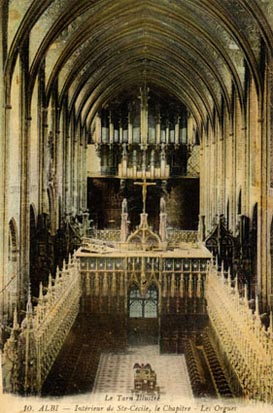 Albi - Sainte-Cécile before 1904
Albi - Sainte-Cécile before 1904
1. – The organ, from Moucherel to Peyroulous (1736-1824)
On the 20th of october 1734, the archibishop of Albi, the Most Reverend Armand-Pierre de la Croix de Castries, commissioned a new instrument from Christophe Moucherel, to replace the old gothic organ of the cathedral..
Moucherel, in a kind of short autobiography, described himself this way:
« I was born in Toul in 1686... my father was an inn-keeper. From twelve to eighteen years old I tought myself to turn, without the hep of any turner, I joined the army in 1705, when I was 18 years old... I did three campaings in Germany, when I was 21 years old... I have been received master carpenter in Toul... at the age of 24 I got married to my misfortune, I married Anne Rutton...
I know three main professions, disregarding several other small ones, which I have never been taught... My first profession was turner and carpenter which I performed in Toul for three years, being a master there, the second is organ builder in Metz for 12 years... The third being printer die caster, which I did three years, both in Metz and Paris... I begun my first organ in 1716... I was thirty then... I did twelve of them... »
Master carpenter, he certainly was, considering the momumental case (16.2 meter wide, 15.2 meters high), decorating the rear of the cathedral. The organ became rapidly reknown, and a drawing of the case will be published in the IVth volume of the « Histoire du Languedoc » by Dom Vaissète, published in 1742.
The specification was the folowing:
Montre 8' - Bourdon 8' - Prestant 4' - Flûte à cheminée 4' - Nazard 2' 2/3 - Doublette 2' - Tierce 1' 3/5 - Larigot 1' 1/3 - Fourniture 4 rangs - Cymbale 2 rangs - Cromorne 8'.
II - Grand Orgue (50 keys, C1-d5, whithout Cis1):
Montre 16' - Bourdon 16' - Montre 8' - Bourdon 8' - Gros Nazard 5 1/3 - Prestant 4' - Flûte à cheminée 4' - Grosse Tierce 3' 1/5 - Nazard 2' 2/3 - Doublette 2' - Quarte de Nazard 2' - Tierce 1' 3/5 - Fourniture 6 rangs - Cymbale 4 rangs - Grand cornet 5 rangs - Trompette 8' - Voix humaine 8' - Clairon 4'.
III - Récit (27 keys, c3-d5):
Cornet 5 rangs - Trompette 8'.
IV - Écho (39 keys, c2-d5):
Bourdon 8' - Prestant 4' - Nazard 2' 2/3 - Doublette 2' - Tierce 1' 3/5 - Fourniture 3 rangs - Cromorne 8'.
Pédale (27 keys, C1-d2, A0 on Cis1):
1ère Flûte 8' - 2ème Flûte 8' - Flûte 4' - Trompette 8' - Clairon 4'.
During the instrument inspection, on the 2nd of december 1736, the organist of the cathedral of Mende – Gilbert Sauvage – Quote several defects :
« When one plays the Positif keyboard, number of keys speak twice...this is a very noticeable defect...The builder have to make several keys of the great keyboard softer, as they are hard and speak only when they are half pressed...He should have the naturals of the pedal keyboard go a lot more down when pressed... the pedals of trumpet are not noisy enough... as the pedals of clarion dominate them...It is the same for the Grand-Orgue trumpet which pipes are a bit weak... »
On the 23 of september 1737, new inspection of the instrument by Laurent Desmasures, organist of the abbey of Moissac.
As always with Moucherel organs, several problems rapidly appear...
In 1747, François L'Epine (father) and Jean-François L'épine (son) rebuilt the windchest for the Positif, the Grand Orgue and the Pédale.
Writing quoted by Jean-Baptiste Puget on a pedal windchest bar:
Those pedal windchests, the Grand-Orgue ones and the Positif ones have been built in 1747 by François L'épine the oldest, and have been helped by Jean François L'épine his oldest son- In Albi on the 2nd of august 1747.
The L'Epine will restore several stops and add a 16' Bombarde to the Pedal, a Trompette and a Clairon to the Positif and will replace the Grand-Orgue 4' Flûte à cheminée by a second 8' Trompette .
In 1778-1779, Joseph Isnard carried on a great restoration of this instrument. He also add a Cornet on the Positif, merged the Fourniture and the Cymbale of the same keyboard on a single register, and add a Bombarde keyboard, with this specification:
1ère Bombarde 16' - 2ème Bombarde 16' - Trompette 8' - Clarinette 8' en chamade (Do3) - Hautbois 8' (Fa2) - Clairon 4' - Cornet 5 rangs.
Since 1818, Antoine Peyroulous organ builder from Toulouse, maintained the instrument, carried on some work in 1817 and was asked in 1824 to perform an important restoration with modifications to the specification and additions of several new stops :
One out of the two bombardes were then moved to the Grand-Orgue, in place of the Clairon, which replaces the Quarte de Nasard, suppressed. A second 8' Trompette replaces this Bombarde. A 16' Flûte, chestnut made, takes place at the Pedal keyboard, and a Clarinette treble en chamade is installed at the Positif. The specification is then:
I - Positif (50 keys, C1-d5, whithout Cis1):
Montre 8' - Bourdon 8' - Prestant 4' - Flûte à cheminée 4' - Nazard 2' 2/3 - Doublette 2' - Tierce 1' 3/5 - Larigot 1' 1/3 - Fourniture 6 rangs - Cornet 5 rangs - Trompette 8' - Cromorne 8' - Clarinette en chamade 8' (Fa2) - Clairon 4'.
II - Grand Orgue (50 keys, C1-d5, whithout Cis1):
Montre 16' - Bourdon 16' - Montre 8' - Bourdon 8' - Gros Nazard 5 1/3 - Prestant 4' - Grosse Tierce 3' 1/5 - Nazard 2' 2/3 - Doublette 2' - Tierce 1' 3/5 - Fourniture 6 rangs - Cymbale 4 rangs - Grand cornet 5 rangs - Bombarde 16' - 1ère Trompette 8' - 2ème Trompette 8' - Voix humaine 8' - Clairon 4'.
III - Bombarde (50 keys, C1-d5, whithout Cis1):
Bombarde 16' - 1ère Trompette 8' - 2ème Trompette 8' - Clarinette 8' en chamade (Do3) - Hautbois 8' (Fa2) - Clairon 4' - Cornet 5 rangs.
IV - Récit (27 touches, c3-d5)
Cornet 5 rangs - Trompette 8'.
V - Écho (39 touches, c2-d5)
Bourdon 8' - Prestant 4' - Nazard 2' 2/3 - Doublette 2' - Tierce 1' 3/5 - Cromorne 8'.
Pédale (27 keys, C1-d2, A0 on Cis1):
Flûte 16' - Flûte 8' - Flûte 4' - Bombarde 16' - Trompette 8' - Clairon 4'.
By 1838, the organ was completely dilapidated ! In 1840-1841, the instrument was restored by the Claude brothers, from Mirecourt. The manual keyboards and the pedal keyboard are made anew, so is the wind system. The Gros Nasard is removed and replaced by a Dessus de Flûte (TG), the Grosse Tierce is replaced by a 4' Flûte . A 4' Flûte Allemande takes the place of the Larigot. Two gambas are added to the Récit, and the Cornet d'Echo is made anew.
Those works will appear to be catastrophic for the instrument ! Instead of restoring the windchests, the Claude brothers will simply decrease dramatically the pressure to minimize the runnings, with the consequence « alteration of all the stops ». During the inspection of the instrument, on the (???) of october 1841, the Commission of Art and Religious Buildings (Commission des arts et édifices religieux) expert -Charles Simon- observes:
« ...the wind system is too small for the instrument size... All the foundation stops had their mouth cut higher, the languids thinned... All the reeds tongues have been flattened, the curvature is lost... This work is a guilty deface of an instrument whose sound quality was formerly excellent and had been subject to the general admiration... »
In 1845, Aristide Cavaillé-Coll submitted a quotation for the instrument's rebuilding, which never will be answered. In 1856, Frédérick Junck, rebuilt the wind system and the pedal keyboard mechanisms, changed several windtrunks, restored the facade pipes and changed the reed tongues. In 1865, new restoration by Thiébaut Maucourt (1835-1882) : the Claude brothers keyboards are replaced, the couplers replaced by sticker couplers, a 10 stop Récit Expressif (TC) replaced the old Récit :
Salicional 8' - Gambe 8' - Voix céleste 8' - Flûte octaviante 4' - Dulciana 4' - Trompette 8' - Hautbois 8' - Voix humaine 8' - Euphone 8' - Clarinette 4'.
Later on, Théodore Puget will remove the Grand-Orgue Cymbale, Tierce and Voix Humaine, replaced by a 8' Salicional, a 4' Flûte, and a 4' Gambe. The Positif Tierce will be removed too, so are the two Clarinettes en chamade. The Récit Flûte Octaviante will give place to a 2' Octavin.
3. – The Jean-Baptiste Puget reconstruction (1903-1904)
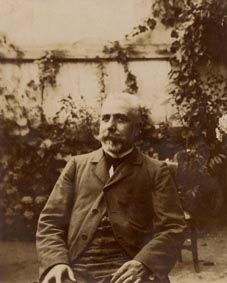 Jean-Baptiste PUGET (1849-1940)
Jean-Baptiste PUGET (1849-1940)
N.B. Jean-Baptiste Puget has never been called by his real first name. His brothers used to call him Théodore, his father (Théodore Puget) refers to him as « Jean-Baptiste said Théodore » in his will, and himself used to sign all his letters Théodore Puget.
At the begining of the XXth century, the organ is once more in a very bad condition ! The last works, though performed by talented organ builders (Clavel, Maucourt, Théodore Puget), had been very temporary, due to the lack of money for some serious work, on an instrument previously ruined by the Claude brothers poor workmanship. The organ specification is then:
I - Positif (50 keys, C1-d5, whithout Cis1):
Montre 8' - Bourdon 8' - Flûte allemande 8' - Prestant 4' - Petite flûte 4' - Nazard 2' 2/3 - Doublette 2' - Plein jeu - Cornet 5 rangs - Trompette 8' - Cromorne 8' - Clairon 4'.
II - Grand Orgue (50 keys, C1-d5, whithout Cis1):
Montre 16' - Bourdon 16' - Montre 8' - Bourdon 8' - Flûte traversière 8' - Flûte 8' (Sol2) - Salicional 8' (Do2) - Prestant 4' - Flûte 4' - Gambe 4' - Nazard 2' 2/3 - Doublette 2' - Fourniture 5 rangs - Grand cornet 5 rangs - Bombarde 16' - 1ère Trompette 8' - 2ème Trompette 8' - Clairon 4'.
III - Bombarde (50 keys, C1-d5, whithout Cis1):
Bombarde 16' - 1ère Trompette 8' - 2ème Trompette 8' - Hautbois 8' (Fa2) - Clairon 4' - Cornet 5 rangs.
IV - Récit (39 keys, c2-d5)
Dulciana 8' - Gambe 8' - Voix céleste 8' - Petite flûte 4' - Octavin 2' - Trompette 8' - Hautbois 8' - Clarinette 8' - Euphone 8' - Voix humaine 8'.
Pédale (24 keys, C1-c3, whithout Cis1) :
Flûte 16' - Flûte 8' - Flûte 4' - Bombarde 16' - Trompette 8' - Clairon 4'.
In 1902, Jean-Baptiste Puget intervenes with the father Vilote, priest of the cathedral, in unambiguous terms :
« I call for your carefull attention to report unto you the pitiful conditon of the metropolitan cathedral Grand Orgue. Yet in 1880, when the Most Reverend Ramadié have been good enough to ask us to tune the cathedral organ, the previous organ builder in charge of the tuning stated that the organ couldn't go further without major repairs. Twenty years later, the Grand Orgue condition has not improved, far from this, and the big pipes of the Montre, eaten by the dust or not sustained enough, begun to collapse on their feet and may fall... In my opinion, a few big pipes won't be long before collapsing completely, the metal is soft, and when a fold appears, it rapidly enlarges and the pipe, then shortened, is no longer retained by the top carvings of the case, and consequently falls. There are pipes held by only a few centimeters. A few years ago, we quickly installed suspensions for the biggest pipes, nearly collapsing, and have been blamed by the Most Reverend Hardy for that. So, we won't do anything else to prevent pipes from falling in the future. but I thnk it is my duty to warn you about the worrying condition of the Montre pipes, and generally speaking, of the whole organ.
In Ste Cécile, It would be necessary for you to have to realise at least the first part of the quotation I had the honour to submit to the Most Reverend Fonteneau on october 1896. It includes the repair and reinforcement of the Montre pipes, the cleaning and fixing of the whole inside, what we organ builders call an overhauling – which works cost was estimated to 7565 Fs, price that I maintain, despite the fact that the instrument condition has worsed in six years.
The second part of the quotation concerned the complete and artistic restoration of the organ ; and was estimated to 39,464 Fs... »
Puget concludes his letter in terms that does not let any doubt upon his intentions:
« I'm really eager to be in charge of the work necessary in Ste Cécile, and I'll make any concessions to obtain it... »!!!
In a second letter, contemporary to the previousy cited one, but writyen to His Grace the Most Reverend Mignot, archbishop of Albi, he points out:
« ... For 20 years, I have done all I could but I cannot prevent the dust from invading the whole organ, blocking pipe mouths, so that important parts do not speak anymore, or are very weak. Moreover, numbers of wooden pieces are worm-eaten, breaking under the weight of the parts they are supposed to hold, or leaking through worm holes... Despite the fact that I'm interested in obtaining a repair of the organ of Ste Cécile, and hence that my sayings can sound suspect, I do not hesitate to stress this point to Your Grace, persuaded I am that twenty years of faithful duty will prevent me from all venial accusation. »
 Jean-Baptiste PUGET's signature
Jean-Baptiste PUGET's signature
In a new letter (undated), addressed to the Achbishop, Jean-Baptiste Puget points out the worsening of the instrument condition:
« ... Some time ago, a tin pipe from the Montre had fallen into the chancel, and could have cause a serious accident ; but all the facade pipes are in the same condition and are about to end the same way... This is the same for the tower decorations...there are some big angels just held by a few nails in their feet. » And he proposes a temporary solution : « If the parish funds are unsufficient, and if the State does not provide any funds for repair to the Montre pipes and the carvings strengthening, a wise and careful solution will be to remove the less stable pipes. The organ sight will be very ungainly, and then perhaps it could motivate a generous donator for to help to restore it to its original splendour... »
The task is of importance:
« ...The work would last about 4 monthes, and require 215 11-hours working days for organ builders, specialised mechanicians, welders, voicers and 250 working days for local workers, carpenters, locksmiths, blowers, keyboard holders... »
To back up his request, Puget will not hesitate, in a letter dated from the 6th of December 1902, to refresh the cathedral priest's memory:
« ... Finally, I hope, reverend, that it will be taken account of my situation at the Metropolitan cathedral, One will not forget that the Most Reverend Fonteneau never paid me the 2000 Fs for the repair and rebuilding of the screen organ in St Joseph church ; that I've been paid only 150 fs out of the 300 fs asked for the dismantling, cleaning, moving and rebuilding of the organ of St Clair ; and that I've never received the smallest account for the works I begun and the numerous travels I did for the building of the chancel organ the Most Rev. Fonteneau ordered me... » !!!
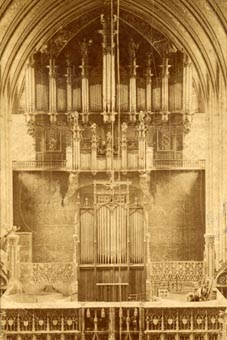 Inside of the cathedral before the transfer of the small organ
Inside of the cathedral before the transfer of the small organ
in Albi's St-Joseph church in 1886
In a three part quotation established on the 30th of march 1903, Puget proposes at first to restore, strengthen and clean the façade pipes, to clean the instrument, mechanic and pipework, to fix all the wind system leaks, to restore all the pipes, change all the tuning springs of all reed stops, and to revoice and tune the whole organ. All those works are estimated to 5,075 francs.

In the second part of this quotation, Puget proposes to rebuild anew a four keyboard block of 56 keys, covered with nice ivory, and a oak made pedal keyboard with rosewood covered sharps. Some room will be left to install 18 combination trigger-pedal-pedals. The keyboards, pedal keyboard and trigger-pedals will be placed in accordance with the measures and indications established at the Malines Congress. The keyboards will be kept in a desktop-like cabinet, lockable.
All stop knobs will be reordered by keyboard, and all the porcelain labels changed, with black fonts for flue stops and red fonts for reeds. The pedal tracker will be made anew, and double valves installed for to provide a more appropriate feeding for the basses. Inside he organ, under the windchests, will be installed two large bellows, with an area of 3 sqm each. The entire facade pipes holders will be replaced so will be « POSTAGES » feeding it.
A Barker lever will be installed, in order to compensate the valves resistance, and to allow the keyboards to be coupled, what is impossible nowadays, the couplers will be extended to three : Récit-Bombarde and Positif on the Barker assisted keyboard, a fourth trigger-pedal will call the Grand-Orgue; that is four trigger-pedals with their mechanisms. Il will also be installed three trigger-pedals allowing to have the basses of the Grand-Orgue, Bombarde and Positif to speak with the pedal keyboard, so that this keyboard has the whole organ power. In order to make the organist play easier, three trigger-pedals will be established allowing to call the reed stops of the Grand-Orgue, the Bombarde and the Pedal. Some room will be made on the pedal windchests to extend it up to 30 keys.
The windchests of the Grand-Orgue, Bombarde and Positif will have added 6 notes, so that they have the full keyboard compass. On the Grand-Orgue windchests, the 5 bass pipes mixed with the trebles will be moved with the other basses, letting a vast place in the middle of the organ, where a nice Récit could be placed later, which is impossible nowadays.
A new windchests or a second valves rank will be made for the Bombarde, so that three new stops could be installed, that is : a large scale 16' Bourbon, a large scale 8' Flûte Harmonique, a 8' Principal or a Violoncelle. A swell box, made of thick wood will be made, in order to host all the Bombarde stops. The swelling of all those great stops will be very usefull, as the present Récit is very weak, near to nothing, while the Bombarde swell will provide a very efficient forte, which will be one of the great features of the organ.
As will be done on the Bombarde, a second ranks of valves will be installed on the Grand-Orgue, to feed properly the 18 stops of the Grand-Orgue, and especially the reed stops. Those valves will be enclosed in a second bottom board, allowing to install a ventil system for the Grand-Orgue, which is impossible otherwise. On those windchests, room will be made for 3 new 8' stops, to be installed later. The 8' Flûte and 8' Salicional will have their basses completed, wich they lack at the moment.
The Positif windchests will be moved apart which will make a lot of room, and will make the sound further from the organist, the pipes being too close at the moment. The windchests will be modified as necessary (room, upperboard appertures, registers, etc.) for two 8' stops to be installed later.
Finally, the whole organ will be tuned to the normal pitch of 880 vibrations.
In the third part of the quotation, Jean-Baptiste Puget Proposes a nice 12 stops Récit with 56 keys, enclosed in a vast swellbox; there would be some new stops to complete the enclosed stop ensemble, necesary for a great organ as the Ste Cécile one. The stops already present on the Récit would be modified in order to match the rest of the organ scales, and would all be completed up to 56 notes. The as completed Récit will be coupled to the Bombarde keyboard using two couplers : 1° Récit on Bombarde; 2° sub-octave Récit on Bombarde. Those couplers would make the Bombarde touch a bit heavy, and a special Barker system should be installed. A ventil pedal for the Récit reed stops, a trigger-pedal for the Bombarde tremulant, and a new tremulant for the Récit.
On the Grand-Orgue windchest, a new stop of 8' Diapason will take place, with 56 pipes; on the Positif : a 8' Keraulophone and an 8' Unda Maris; on the Pedal the six stops will be completed each one with 5 pipes, so that they reach 30.
The existing wind system being insufficient for feeding properly all those stops and the incoming pedal stops: a big bellows fitted with six suspended pairs of pumps will be built. This bellows wil be 7 meters (sic) in area the inside covered with parchment and externally varnished. The existing system will be used as regulating system.
Finally, in order to give the whole organ a powerfull but not shouting base, a complete reconstruction of the Pedal is proposed. The windchests in place, supporting the existing stops are too small to be aded some new stops ; they will be completed with new windchests, holding a full lenght 32' Flûte Ouverte, extended in 16', 8' and 4', a 16' Bourdon, extended in 8', and a 8' Violoncelle. Those three last stops will be installed instead of the old 16', 8' and 4' Flûtes, removed. The new flûtes would take place on a special windchest in two parts, laying directly on the organ loft floor. A new 2 sqm bellows would be installed near each one of the new windchests to feed the 4 flûtes.
Finally, a 16' Bourdon and a ventil pedal would be added on the Positif.
The whole works for this third part being estimated to 13,320 Francs, that is to say a total amount of 29,050 Francs for the entire quotation. Puget will accept a 655 Francs reduction, for a total amount of 28,395 Francs.
This quotation, despite the importance of the work proposed, felt rather like a big refurbishing, which is why it was turned down.
A new contract was signed in Albi, on the 17th of June 1903.
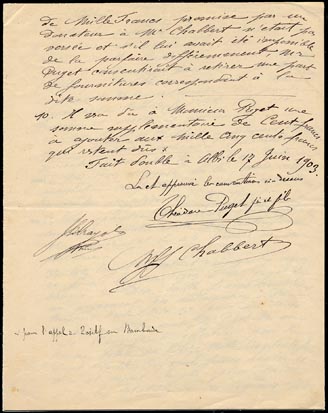 17th of March 1903 convention, page 3
17th of March 1903 convention, page 3
Between the undersigned : M. Puget, organ builder in Toulouse, and MM. Crayol, superior of the cathedral of Albi choir, Chabbert, chaplain of the general hospital of Albi, both in charge to provide the complement for the cathedral of Albi great organ restoration, in the name of the Archbishop of Abli, it has been agreed and resolved as follows :
1° MM Crayol and Chabbert approve the fulfilment of the third art of the modified quotation presented by Mr Puget on the 28th of may 1903 and signed by him ; But this approbation contains the following reservations and conditions agreed by Mr Puget :
2° The Récit repairs, costing four thousand five hundred francs, will be delayed, and this sum will not be paid.
3° MM. Crayol and Chabbert engage themselves to pay to Mr Puget on this day, the 17th of june 1903, the sum of ten thousand francs, for the anticipated payment of the works of the 3rd part of the quotation.
4° Those works, Mr Puget on his side engage himself to realise for the sum of eleven thousand and five hundred francs, of which one thousand and five hundred francs will remain owed, and will be paid later. On the whole of those works, Mr Puget engages himself to add the following suplementry works. Those works will be realised without possible increase of the final quotation price, as agreed for the former parts of the quotation between Mr Puget and the Most Reverend Archbishop.
5° The manual keyboards will be estabished in the following order : 1° Récit, 2° Positif, 3° Bombarde, 4° Grand-Orgue, and the Positif will be coupled to the Bombarde as it is also planned for the Récit.
6° All the mechanical transmissions for the opening of the already existing stops will be replaced by pneumatic transmission, as for the new stops, and the drawstops reduced to the smallest possible dimensions.
7° Five new drawstops will de added, allowing to prepare stops on each keyboard and pedal keyboard, and a trigger-pedal drawing those five drawstops alltogether.
8° Mr Puget engage himsef to make all possible efforts to achieve the organ for the 22th of november 1903, for the Ste Cécile celebrations.
9° Finally, if despite all conjectures and probabilities, the sum of one thousand francs, promised by a donator to Mr Chabbert was not given and if it would have been impossible to gather this sum by different means, Mr Puget would accept to retain an equivalent part of supply.
10° One hundred francs will be owed to Mr Puget in addition of the one thousand and five hundred remaining owed [For the Positif/Bombarde coupler].
On the 24th of october 1903, a new contract amends the former one :
Between the undersigned : M. Puget, organ builder in Toulouse, and MM. Crayol, superior of the cathedral of Albi choir, Chabbert, chaplain of the general hospital of Albi, both in charge to promote the restoration of the great organ of Sainte-Cécile of Albi, it has been agreed what follows, modifying the previous quotations already agreed, but without any increase of the final price, which remains at thirty thousand francs, without possible increase as it have always been agreed previously.
MM.Crayol and Chabbert agree to : 1° the removal of five trigger-pedals calling for the foundation stops and the two trigger-pedal calling for all fundations and reed stops. - 2° the extension of all pedal reeds. - 3° the removal of the Echo/Récit coupler. - 4° the shortenings (sic) applied to the swellboxes, the wind system. - 5° the drawstop system by key ; 6° the immediate payment by advance of the of sixteen hundred fancs (1600 f) remaining to reach the eleven thousand six hundred francs, total price of the third part of the quotation, from which ten thousand have already been paid.
On his side Mr Puget will compensate by the following improvements, judged fair by both parties:
1° The Echo will be removed from the former Positif case and placed in the main case of the organ.
2° The Récit will have a 16' Cor Anglais instead of the 16' Euphone initially planned, which one will go with the Cromorne (both in 8') on the Echo. The 16' Bourdn will be a Quintaton. The Trompette will switch with the Trompette Harmonique of the Positif-Bombarde.
3° The Positif-Bombarde will have a 8' Baryphone instead of the second Trompette and a new 8' Clarinette with french shallots (« à larme »), instead of the planned Basson.- The Clairon planned will be harmonic. The reeds of this keyboard will be on the pneumatic transmission pressure.
4° New tongues and shallots will replace those of the old reeds of the organ.
5° A crescendo-decrescendo balanced pedal, applying to all the stops of the organ will be installed.
6° Finally, despite several details unquoted precedently, the organ will be achieved according to the following table:
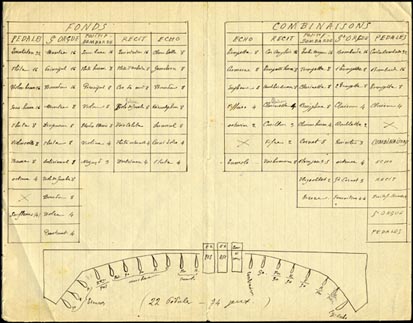
It is this last agreement, and the generosity of multiple donors, that are going to give to the organ the definitive face and the following specification:
I - Grand Orgue (56 keys, C1-g5) wind pressure 4 ½’’ :
Montre 16' - Principal 16' - Bourdon 16' - Montre 8' - Diapason 8' - Bourdon 8' - Flûte 8' - Salicional 8' Gambe 8' - Prestant 4' - Gemshorn 4' - Octave 4' - Quinte 2' 2/3 - Doublette 2' - Fourniture 3 à 6 rangs - Grand cornet 5 rangs - Bombarde 16' - 1ère Trompette 8' - 2ème Trompette 8' - Clairon 4'.
II - Positif expressif (56 keys, C1-g5) wind pressure 5 ½’’ :
Sous-Basse 16' - Principal 8' - Flûte harmonique 8' - Violon 8' - Unda maris 8' - Salicet 4' - Nazard 2' 2/3 - Flageolet 2' - Tierce 1' 3/5 - Plein jeu 3 à 5 rangs - Cornet 5 rangs - Tuba magna 16' – Trompette 8' - Baryphone 8' - Clarinette 8' - Clairon 4'.
III - Récit expressif (56 keys, C1-g5) wind pressure 5’’ :
Quintaton 16' - Flûte d'orchestre 8' - Cor de nuit 8' - Viole de gambe 8' - Voix céleste 8' - Flûte octaviante 4' - Dulciane 4' - Octavin 2' - Carillon 3 rangs - Cor anglais 16' - Trompette harmonique 8' - Hautbois-Basson 8' - Voix humaine 8' - Clarinette 4'.
IV - Écho expressif (56 keys, C1-g5) wind pressure 3 ½’’ :
* Clarabella 8' - Bourdon 8' - * Gemshorn 8' - Kéraulophone 8' - Suavial 8' - Flûte douce 4' - * Gambe 4' - Piffaro 4' (1 à 2 rangs) (flute celeste) - Fifre 2' - Trompette 8' - Euphone 8' - Cromorne 8'. (* out of the swell box)
Pédale (30 keys, C1-f3) wind pressure: Flues 4’’, Reeds 5’’ :
Quintaton 32' - Flûte 16' - Contrebasse 16' - Sous-Basse 16' - Flûte 8' - Violoncelle 8' - Basse 8' - Octave 4' - Contre-Bombarde 32' - Bombarde 16' - Trompette 8' - Clairon 4'.
Couplers and Combinations
Stop knobs :
Combination Pédale, Grand Orgue, Positif, Récit, Écho.
Pedal toe pistons :
GO/Péd, Pos/Péd, Réc/Ped
Octaves graves GO, Pos, Réc
Reeds Péd, GO, Pos, Réc, Écho
Tremolo Réc, Écho
Expressions Pos, Réc, Écho
Crescendo
Call of the prepared stops
GO/GO, Pos/GO, Réc/GO, Écho/GO, Réc/Pos, Écho/Pos
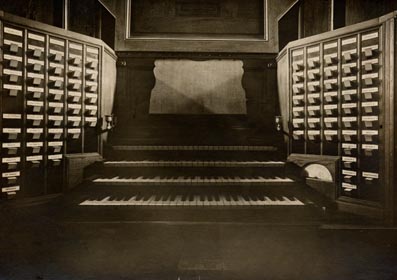
… /…
5. – Some testimonies
… /…
Léonce de SAINT-MARTIN (titular organist in Notre-Dame de Paris) wrote to Puget:
“You know that in the organ of Albi are embodied my holidays and I bless hundred times the Lord to have so well privileged me..."
Albert PERILHOU (titular organist in Saint-Séverin in Paris) wrote to Puget:
“I was amazed by your organ and I tell it to everybody. It is deserving rival of Saint-Sulpice and Notre-Dame, with this difference that it is admirably distributed and that the crescendo pedal gives it an incomparable effect... You are the most avant-gardist French organbuilder !...”
… /…
6. The end…
… /…
The organ of Albi metropolitan cathedral not only was a « chef d'œuvre » of south of France symphonic organ building, but is also the largest instrument of the country after Saint-Sulpice in Paris, and Notre-Dame de Paris. Il was also one of the most beautiful of France!
It was regrettably destroyed to leave place, in 1981, to a neo-baroque organ built by Barthélémy Formentelli from Verona (Italy)…
English translation by Mathieu DELMAS